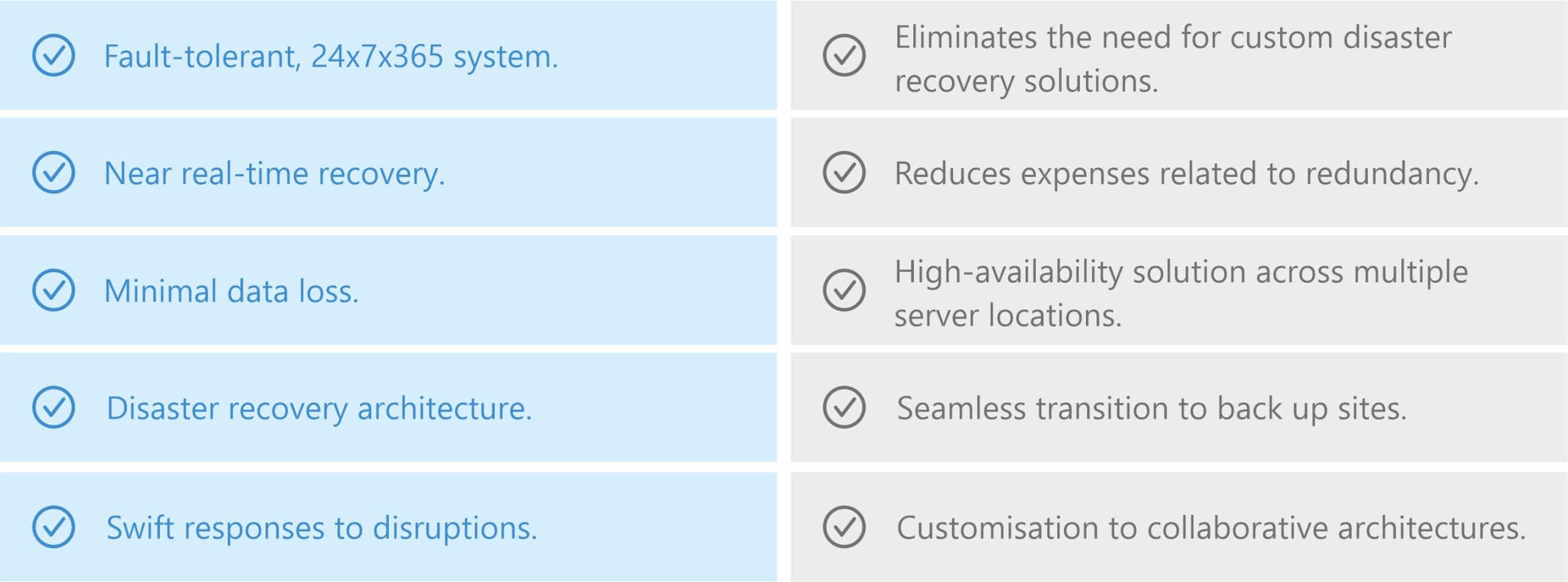
01
As we try to recover from the global disruptions experienced in the last few years, many organisations have come to terms with the realisation that Supply Chain “uncertainty” is here to stay.
02
According to a recent IDC white paper that analysed the strategic significance of IBM Sterling Supply Chain Business Networks, it has become increasingly apparent to businesses that they must enhance their supply chain capabilities to remain competitive.
03
“Data centre downtime” is a phrase that strikes fear in the hearts of any organisation, as it represents the potential for significant disruptions to critical systems and operations. It can have a major impact beyond the business community, including public services, emergency response, and critical infrastructure.
“In our 20-year history, we have designed and developed a number of services and solutions that make our customer’s lives easier and more profitable”
Ian Wells – Chairman and co-founder of Coliance
So, what have the top organisations done to ensure they observe and apply the urgent requirement of resiliency and agility to their supply chain models?
Most organisations have considered or adopted: inventory stockpiling and cushioning, localisation and near shoring, supplier diversification as well as the implementation of strategic partnerships with key raw material suppliers. All helpful changes indeed, but these B2B diversifications have added new layers to the traditional supply chain management model that relied on standalone systems, with little or no data sharing.
As companies change from the simple process of production and provision, they realise that they can no longer operate with limited visibility and marginal real-time data.
In today’s information age, we still require the traditional planning and proper management of inventory, shipping, and tracking, but we can no longer operate without the availability of performance analysis data to identify gaps, delays and errors or forego proper reporting. We can also no longer operate our supply chain management processes without complete visibility across all sectors.
This is why most organisations have chosen to fully digitalise their supply chains with robust B2B integration solutions. This adoption has ensured that their supply chain process is fully dynamic. Those who have successfully adopted B2B Integration are able to automate their sales across multiple sales platforms, they have a global view of their inventory, and they can create, update and process orders with on time delivery utilising pre-established SLAs. Most of all – they operate with scalability for changing strategies and growth that their ERP can manage.
They are now able to adapt to pandemics, political unrest and market disruptions in real time, not only incorporating, but easily managing the new layers required of successful supply chain management. This has helped them achieve ‘Supply Chain Resiliency’ as they gain access to the predictive, analytic and management capabilities that achieve supply chain ‘agility’ goals.
While the opportunities and benefits of B2B integration are clear, actively incorporating a digitalised solution into an existing legacy system or completely embracing a new digital revolution for your company comes with an additional set of problems.
Firstly, the concern of high capital expenditure and secondly, the justifiable anxiety that surrounds the holistic integration of a new process. How can we effectively administer and manage connections between our critical and actionable data to boost our company’s planning and production strategies? Moreover, what do we want our new B2B integration solution to look like?
Coliance has recognised the top Six requirements that all the new B2B integration adopters want to achieve in their drive to attain higher levels of supply chain performance:
At Coliance, we offer managed service models that achieve all the above, optimising your supply chain operations, giving you access to experienced consultants and accelerating your business with reduced costs.
Coliance’s secure managed B2B solutions will meet all your integration needs. We can empower your organisation to respond to customer demands and supply dynamics with optimised visibility into your entire supply chain.
This visibility will enable you to identify operational disruptions, improve your vendor performance, and, by token, boost your profitability, not to mention your competitive advantage.
Agora Platform
This is a fully hosted and fully managed solution for your EDI transactions that includes process monitoring and accelerated Partner onboarding capabilities. The AGORA team will ensure seamless data flow between you and your customers, ensuring quick action on any problem that may arise.
Agora enables businesses to have a full EDI implementation without:
It also provides the following benefits:
Agora Managed Services – This is a service where we take on responsibilities for a customer’s on-premise IBM B2Bi system.
This flexible solution allows customers to define what level of involvement they require from our team. From a simple, scheduled check and report, to full management of all your customer systems and the associated infrastructure. Coliance can integrate, extend and develop your systems, onboard new partners and provide support, consultancy and training at all levels.
Agora Managed Services also provides the following benefits:
In addition, Coliance offers IBM License Management (ILMT) as a service, which maximises your sub-capacity licensing advantage and protects you from being under-provisioned.
Digitalising your B2B supply chain and opting for a secured, managed integration solution is the optimal way to achieve resiliency to new supply chain challenges. However, it is important to choose a solution provider that delivers the experience you are seeking. AGORA overcomes the deficiencies that many B2B integration technologies suffer with today, with a substantial portfolio of connectors and APIs and advanced monitoring capabilities. Coupled this with IBM world class technology either on premise or in a safe and secure cloud environment.
If you want to get all the benefits of a managed service team today, then reach out to one of our experienced consultants. The time has come to empower your organisation to respond to new supply dynamics, improve your vendor performance, and raise your profitability and competitive advantage.
02

Effective EDI (Electronic Data Interchange) management plays a significant role in the above capabilities because EDI allows for the exchange of electronic business documents such as purchase orders, invoices, and shipping notices between trading partners. By streamlining these processes and reducing manual data entry, EDI can improve supply chain efficiency, reduce errors and delays, and provide greater visibility of the status of orders and shipments. All of which ultimately leads to better supply chain performance and a competitive advantage ensuring that your organisation isn’t part of the statistic that loses out to competitors.
There are two schools of thought among those who have recognised the importance of these capabilities: those who choose in-house management and those who prefer a managed EDI service. It is important to take an honest review of both options before making a decision.
We have identified four issues that often prompt customers to seek our help in managing their EDI transactions:
Our first recommendation to our customers is always to address any internal issues within their organisation. This involves careful consideration and planning, and our team offers guidance on how to effectively tackle these steps.
Although some of these steps may seem obvious, it is surprising how often potential customers approach us without having fully thought through these critical stages:
Understand how you currently exchange business documents with your trading partners and identify any inefficiencies, bottlenecks, or challenges in the process.
Determine what types of documents you need to exchange, how frequently you need to exchange them, and what standards and formats are required by your trading partners.
This may involve process changes to improve integration, modifications to existing software and hardware, or implementation of new technology to keep up with the competition.
Understand the capabilities of your current systems and identify any gaps or limitations that may impact your ability to implement an EDI solution.
Research and evaluate EDI solution providers to identify those that meet your requirements and have a track record of success in your industry, like Coliance.
Develop a detailed plan for implementing an EDI solution, including timelines, resources, and testing procedures.
Coliance’s experienced team manage the setup, configuration, testing and monitoring of your supply chain transactions. Our cloud-based managed services ensure easy scalability, reliability, and uptime, promoting better supply chain visibility and relationships with trading partners. If you want to experience substantial savings in labour, infrastructure, and maintenance costs contact Coliance today.
03
Minimising Data Centre Downtime with IBM Sterling Global Mailbox
“Data centre downtime” is a phrase that strikes fear in the hearts of any organisation, as it represents the potential for significant disruptions to critical systems and operations. It can have a major impact beyond the business community, including public services, emergency response, and critical infrastructure.


To
ensure high-availability operations and redundancy, businesses commonly
use approaches such as a database-driven strategy that leverages the disaster
recovery capabilities of a database vendor or operating at a third-party hot
site by transferring copies of the latest backup. However, these approaches can
still result in occasional downtime, as well as recovery latency, and increased
costs.
While there are a few Global Mailbox offerings available in the market, they each have their own drawbacks. One common issue is that some rely on a single data centre, which makes them vulnerable to downtime and reduces their redundancy. Some solutions may not provide the same disaster recovery capabilities, while others may have limitations on data storage and transfer, potentially affecting performance and usability. Another important drawback is the level of customisation and control that companies have over their email infrastructure. Most solutions are restrictive in terms of configurations and integrations.
IBM Sterling Global Mailbox, on the other hand, offers a solution to these common issues. It is not reliant on a single data centre, providing greater redundancy and resilience. Additionally, IBM offers tailored plans based on an organisation’s specific needs, including additional storage and data transfer capacity. Companies using IBM’s Global Mailbox can enjoy greater customisation and control over their email infrastructure, avoiding potential restrictions on configurations and integrations. This makes the IBM Sterling Global Mailbox a highly attractive option for businesses seeking a flexible and resilient Global Mailbox solution.
IBM Sterling Global Mailbox’s all-inclusive solution addresses data centre downtime challenges by implementing private mailboxes, load balancing among data centres, and regular replication for disaster recovery.

Earlier in this article, we showed the various problems that can cause data centre downtime. Now, let us revisit those issues and explore how a Global Mailbox effectively addresses and counteracts each of them:

In summary, IBM Sterling Global Mailbox offers a holistic solution that not only addresses data centre downtime challenges but also revolutionises your organisation’s data management and B2B integration processes.
By leveraging the advanced features of IBM Sterling Global Mailbox, you can eliminate downtime challenges and achieve a high-availability infrastructure, leading to a seamless experience for all stakeholders. By partnering with Coliance, you can unlock the full potential of IBM Sterling Global Mailbox, customised to fit your organisation’s unique needs. Our expert team can guide you through the implementation process, ensuring a smooth transition and maximising the benefits of this innovative solution. Don’t let data centre downtime hold your organisation back – contact Coliance today to learn more about how we can help your business thrive in an increasingly interconnected and fast-paced digital landscape.

Coliance © 2024 All rights reserved